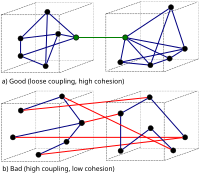Dynamic coupling (computing)

Dynamic coupling in computing is like playing with Legos. When you build a Lego tower or a house, you use different pieces to make it all stick together. These pieces can be connected in many different ways, like snapping them together or using special pieces, like hinges or joints. Just like in computing, when you write a program or an application, you also need to connect different parts together. But, instead of using Lego pieces, you use code that connects these parts.
In dynamic coupling, these parts or components, which are like different Lego pieces, are connected together at runtime. This means that the connection between these parts is not fixed or predetermined. They can change and adapt based on the needs of the application. This is similar to how you can build different things with Legos by changing the pieces and the way they connect.
So, dynamic coupling allows these components to communicate and work together, just like when you play with Legos to build something. It can make the application more flexible and adaptable. However, it can also make it more complex and harder to manage if not properly designed.
In dynamic coupling, these parts or components, which are like different Lego pieces, are connected together at runtime. This means that the connection between these parts is not fixed or predetermined. They can change and adapt based on the needs of the application. This is similar to how you can build different things with Legos by changing the pieces and the way they connect.
So, dynamic coupling allows these components to communicate and work together, just like when you play with Legos to build something. It can make the application more flexible and adaptable. However, it can also make it more complex and harder to manage if not properly designed.
Related topics others have asked about:
